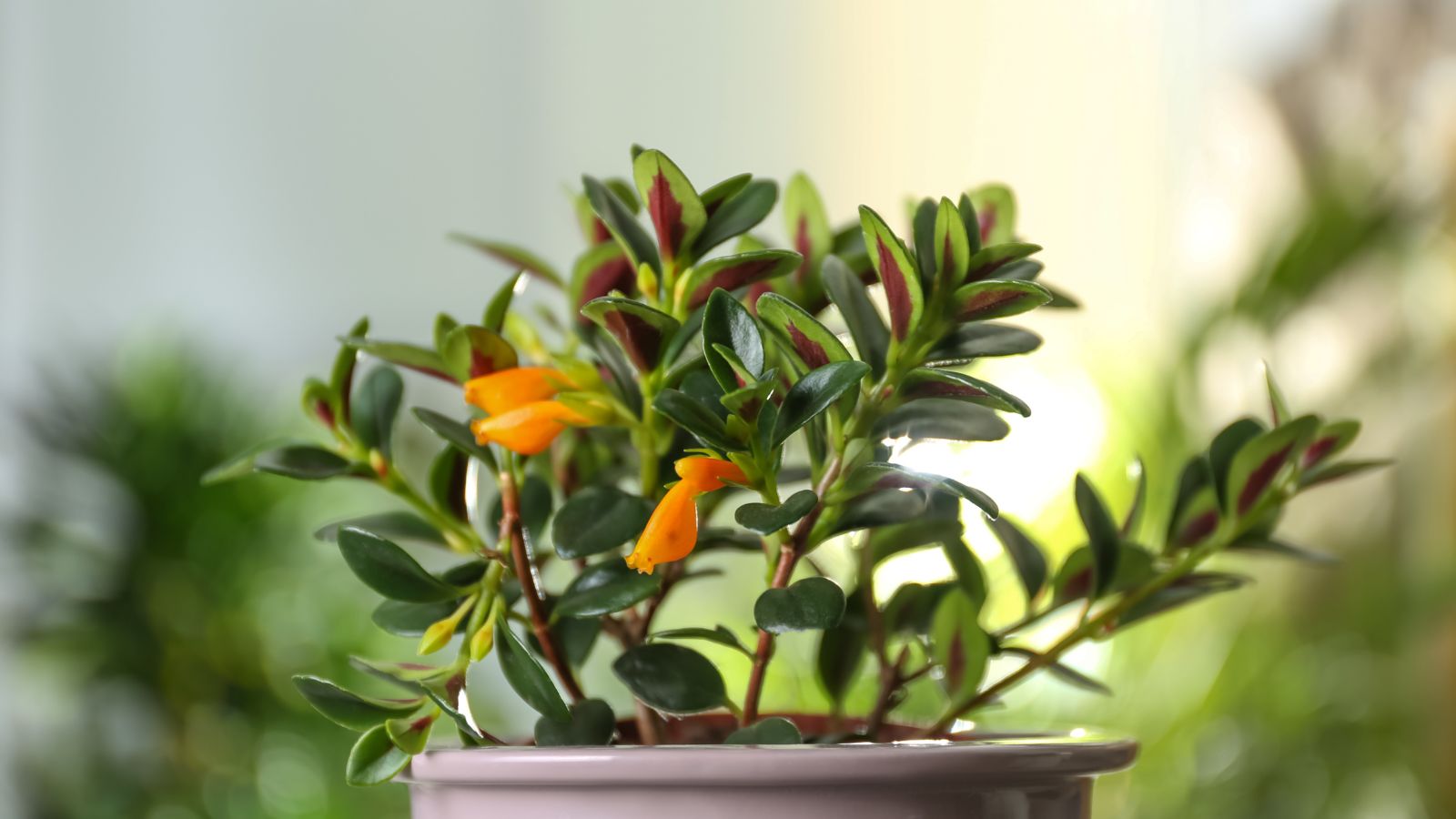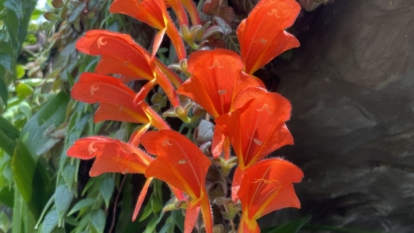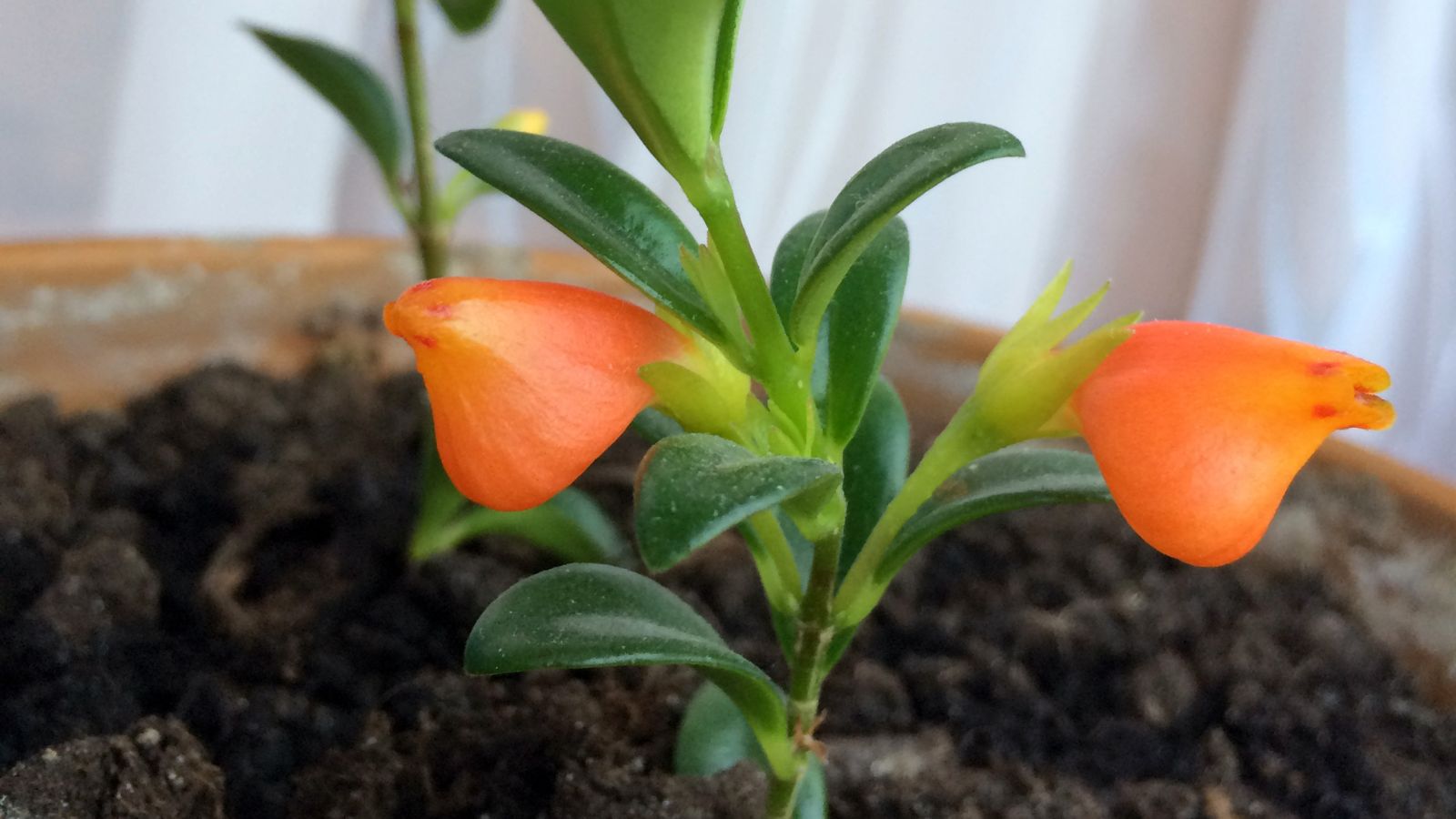How to Plant, Grow, and Care for Goldfish Plant
A few species are referred to as goldfish plants due to their fish-shaped flower buds. These fun orange-flowering shrubs make excellent houseplants. Rachel Garcia explores the types and their care in this growing guide.

Contents
If you had trouble keeping your pet goldfish alive, you might have more luck with the goldfish plant! This houseplant isn’t named ironically – it really does resemble tiny goldfish swimming in a sea of foliage. You’ll be impressed not only with the goldfish plant’s fun appearance but also with its unique growing habits.
The goldfish plant is native to Latin America. It’s a tropical species, which means it only grows year-round in zones 10-11 in the United States. However, it’s easily grown as a houseplant anywhere else in the world. As long as you maintain the right conditions, a goldfish plant can thrive in your home garden.
You’ll get a whole flame of color with these beautiful, non-aquatic “fish”. The colorful flowers come in shades of red, orange, yellow, and even hot pink. The stems are trailing, so goldfish houseplants are perfect as a hanging or table pot. In an outdoor garden, you can position so its stems and red-orange flowers are cascading down a rock wall (imagine how great they’d look by a pond!). Your goldfish plant will also attract hummingbirds to the yard. With so much to love, we’re excited to share how to grow goldfish plants in your own garden!
Plant Overview

|
Plant
Houseplants
Family
Gesneriaceae
Genus
Columnea and Nematanthus
Species
Columnea microphylla, Columnea microcalyx, Nematanthus gregarius
|
Native Area
Costa Rica (Columnea), Brazil (Nematanthus)
Exposure
Bright, indirect sunlight
Height
3′
Watering Requirements
Regular
|
Pests & Diseases
Aphids, mealybugs, spider mites, botrytis mold, mosaic virus
Maintenance
Low
Soil Type
Well-draining
Hardiness Zone
10-11
|
What is The Goldfish Plant?
Goldfish plants are steady growers, but they can be more finicky with their care than other plants from the tropics. Why? As it turns out, these are epiphytes! They didn’t evolve to grow in a hanging basket, garden bed, or even soil – goldfish plants naturally grow on top of others, usually trees. The trees are merely for support though. Epiphytes get their nutrients and water from the air and rain, so they aren’t parasitic. Because they’re self-sufficient like this, gardeners are able to swap out the trees for a hanging basket.
Native Area

The species Columnea microphylla is native to Costa Rica. Columnea microcalyx, also known as Columnea gloriosa, covers an area in Central America from Colombia, Costa Rica, Guatemala, Honduras, Mexico, Nicaragua, Panamá, to Venezuela. The other variety, that is also called a goldfish plant, is Nematanthus gregarius, and this species comes from Brazil. They have the same tropical climates that support species like these and provide the cover of trees and shrubs with extra humidity to allow them to grow well.
Characteristics

When cared for properly, a goldfish plant can live to around ten years. As we mentioned, it likes to be warm and is definitely not frost-hardy. On the flip side, it doesn’t care to be too hot or humid. Once the right conditions are met, the goldfish plant likes them to be the same all year long.
Goldfish plants typically develop flowers in the spring and summer, after which some green leaves fall off and it goes dormant. However, there are some hybrids that bloom year-round. After planting, it only takes 6-10 weeks for red flowers to appear. Each colorful flower has fused petals that form a bent fish shape. Some types have a bulge on the underside of the flower, making it even more goldfish-like. While they’re uniquely beautiful, these tubular flowers sadly don’t have a notable scent.
Supporting the school of fish flowers are woody stems that grow to three feet long. Each stem is lined with slightly succulent, dark green leaves. Most varieties have waxy leaves, but some are fuzzy like their cousin, the African violet. Regardless of texture, it is somewhat poisonous to humans and animals.
Varieties

Goldfish plant isn’t actually a single species, but many different species within the Gesneriaceae family. They’re split into two genera: Columnea and Nematanthus. There are some noticeable differences, which we’ll discuss, but the care requirements are the same for each genus.
Goldfish plants in the Columnea genus are often called flying goldfish because their flowers are thinner and more arched, like the fish are jumping out of the water. The most common one is Columnea microcalyx (they’re so similar that it’s nearly impossible to tell them apart).
The Nematanthus genus often features tubular flowers with a lower bulge. Nematanthus gregarius is a common goldfish plant species, though it’s often mispelled as Nematanthus gregarious.
These two genera are sometimes confused with Aeschynanthus, also known as lipstick plant. They do look very similar, but lipstick plant comes from Asia – a long way away from the goldfish plant’s home!
Planting

Take note of the fact that these goldfish types are epiphytic and tropical when planting. Choose a container with plenty of drainage holes and a soil mix with extra drainage materials like perlite or vermiculite added.
Maintain humidity by misting the leaves or placing a tray of water nearby. If planting from cuttings, use a healthy stem with a few leaves, dip the cut end in rooting hormone, and place it in moist soil or water until roots develop.
How to Grow
Like most tropical varieties, goldfish plant care is tricky. You’ll have to take extra care to mimic its native conditions. Here’s what you’ll need to do.
Light

Place your goldfish plant in a very bright location with indirect light. Too much direct sunlight and intense heat burns the dark green leaves, so place it in an east or west-facing window. However, you can move it to a south-facing spot during the winter when the indirect sunlight is less intense.
Water

The key to care is consistency, especially when it comes to watering. Keep the soil moist but never soaking wet (soggy soil is a beacon for disease). Water whenever the top few inches of the soil dry out. Use room-temperature water instead of cold water that can stun the roots. In the winter, you can cut back slightly on watering.
Goldfish plants require moderate humidity – not too much or too little. If your basic household humidity isn’t cutting it, you’ll need to mist the leaves daily with tepid water or use a humidifier. Alternatively, you can fill a tray with pebbles and water, then place it directly below the goldfish plant. This DIY humidity tray won’t produce as much water vapor as a humidifier, but it does help a bit.
Soil

Epiphytes don’t usually have their roots in the dirt, so we need a very well-draining soil. Look for soils that contain sphagnum moss, peat moss, vermiculite, or perlite. African violet soil works well here, along with potting soil meant for orchids. The hanging baskets or containers you use must have adequate drainage holes.
Whether you use African violet potting mix or a homemade mixture, ensure it’s a rich potting soil that’s slightly acidic and drains quickly. Feel free to add compost to the mix in order to improve soil fertility and drainage.
Temperature

Unless you live in zones 10-11, keep your goldfish plant indoors year-round. These tropicals prefer temperatures from 65-75°F (18-24°C), which is perfect for indoor gardening. If you keep them outside, place them somewhere that gets light shade in the heat of the afternoon. To keep it alive, the temperature must stay above 55°F (13°C).
Fertilizing

In the spring and summer, feed your tropical native every one to two weeks. Use either a balanced, water-soluble fertilizer or one that’s high in phosphorous. Alternatively, you can apply a slow-release formula at the beginning of the growing season. In the fall and winter, when growth slows down, only fertilize monthly.
Maintenance

Goldfish plant grows three foot long stems, but it’s recommended to keep them trimmed to one foot. Doing so helps the plant redirect its energy into more blooms. It also helps encourage branching, building a bushier plant instead of a leggy one. Prune in early spring, before it starts to develop those gorgeous red flowers.
Even when actively growing, these houseplants like to be slightly root bound. Only transplant every few years, when there’s simply no room left in the pot for new root growth. You can prune some older roots while you’re at it to build a healthier root system.
Propagation

Goldfish plant is pretty decent at vegetative propagation, so you can technically keep the same one alive for way longer than ten years. The most common way is to use stem tip cuttings, which you’ll often have a plethora of after pruning!
Take stem tip cuttings that are two inches long and have a few dark green leaves. Don’t use stems that have any flowers or buds – we want all the cuttings’ energy focused on growing new plants, not flowering. The parent plant should be healthy and mature.
Dip the cut end of the stem into some rooting hormone and stick it straight up in a small pot of well-draining potting mix (make sure it has good drainage holes!). Keep the soil and leaves consistently moist while the cutting develops its own roots. You can even position a clear plastic bag as a temporary, high-humidity dome, as long as it doesn’t touch the cutting. Give your cutting a good amount of bright light and you’ll soon have a brand new goldfish plant! They should flower the following year.
Common Problems
Goldfish plants come with their share of problems. If you know what to look for though, you’ll be able to tackle whatever gardening issues come your way!
Growing Problems

When something goes wrong with a goldfish plant, its first reaction is to drop some leaves. While this distress signal is easy to recognize, it could mean a number of things. Usually, the culprit will be some sort of inadequate care, such as:
- Dry and/or cold air
- High humidity
- High heat
- Overwatering
- Cold water in the soil.
Sometimes, leaf drop can be a sign that your goldfish plant is going dormant. This is usually accompanied by slowed growth and disappearing flowers. You should cut back on watering until new growth resumes (usually in about six weeks).
If it isn’t dormant, overwatering is the most likely cause of leaf drop. You’ll also notice wilting and discoloration. To help your ironically drowning fish, repot in fresh soil and cut back on watering. It’s important to fix this problem before the extra moisture invites mold and fungal growth.
Finally, if it doesn’t get enough bright, indirect light you’ll notice some leggy growth. Called etiolation, the stems are stretching out in search of more direct sunlight. While this doesn’t necessarily hurt your goldfish plants, it does make them less attractive. Since stretched stems can’t shrink back, you’ll have to prune them shorter, move the plant somewhere sunnier, and wait for new, bushier growth.
Pests

Goldfish plants may be exotic, but their pests are very familiar. To start with, they’re very susceptible to aphids and mealybugs. These are both sap-sucking pests that will drain your goldfish plant of its juices. Along with insects living under the leaves, you’ll notice yellowing foliage that eventually turns brown and dies. These pests also leave behind a sticky honeydew that attracts ants.
If you’re only dealing with a small population, simply clip off the infested leaves and destroy them away from your garden. If you’re growing outdoors, give it a strong spray of water to wash away the pests. For large infestations, apply neem oil, or diatomaceous earth.
Spider mites are teeny-tiny mites that spin silky webs all over. They’ll feed on the leaves, leaving yellow or brown stippling. If left alone, these mites will eventually kill your goldfish plant. You can treat them similarly to aphids and mealy bugs. Try spraying them with water, removing infested leaves, or coating with neem oil. To prevent these mites, keep it clean, moist, and healthy.
Diseases

Goldfish plants are very vulnerable to botrytis bunch rot. This gross mold spreads fuzzy, gray spores across the leaves which, needless to say, we don’t want in our gardens. Botrytis likes high humidity, which explains why the moisture-loving goldfish plant is so susceptible to it.
To prevent botrytis mold, ensure that your houseplant is pruned enough to allow good air circulation between the leaves. You should also remove any debris, such as spent flowers and leaves. If your preventative efforts are in vain and botrytis shows up on your plants, try using neem oil.
Mosaic virus is another threat to our funky goldfish plants. Unfortunately, there isn’t a cure for this virus, so it must be prevented or at least contained. If you notice any leaves with mottling, immediately clip them off and destroy them far away from your garden. Thoroughly sanitize any gardening tools you use to prevent the virus from spreading. It’s tricky to prevent this virus from showing up entirely, but you should always buy your seeds from a reputable buyer and perform a careful inspection of any new varieties you bring into your garden.
Frequently Asked Questions
Is a goldfish plant a succulent?
Yes, but it’s not as succulent as the chunky rosettes in the Crassulaceae family. The goldfish plant has succulent leaves that make it somewhat drought-resistant.
Is the goldfish plant poisonous?
Slightly, yes. Unlike African violets, the goldfish plant has toxic amounts of chemicals such as oxalates and glycosides.
Can a goldfish plant go outside?
Only if you live in zones 10-11 or Central America. Anywhere else, you should keep your leaping goldfish plant indoors year round. Even if it’s warm out during the summer, Columnea gloriosa will dislike the sudden change in its humid environment if moved outside.
How long do goldfish plants live?
Goldfish plants usually live around ten years. However, you can propagate these excellent houseplants so that they technically live longer.








